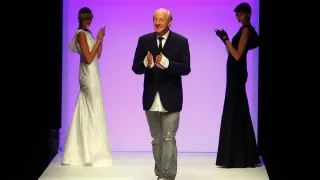
6 hours ago
Champion Gymnast Charlie Larson Opens Up: Athletics, Beyoncé Alter Ego, and LGBTQ+ Visibility
READ TIME: 4 MIN.
Charlie Larson, a celebrated gymnast for the University of Michigan, is not only making headlines for his athletic prowess but also for his unapologetic embrace of queer identity and self-expression. In a recent interview with Queerty, Larson spoke candidly about his experiences as a champion gymnast, his Beyoncé-inspired alter ego, and the importance of visibility for LGBTQ+ athletes in a culture that has often demanded conformity. His story, marked by resilience and joy, is resonating widely within and beyond the LGBTQ+ community .
Larson’s career as a gymnast is distinguished by his technical skill, discipline, and leadership on the University of Michigan team. Yet, his impact extends well beyond the gymnasium. By publicly celebrating his relationship with Beau, a fellow athlete and cheerleader, Larson has become a beacon for queer youth and athletes who see their own struggles and aspirations reflected in his journey .
Larson has described the transformative power of his relationship, noting, “He’s become a support system that I never knew I needed. ” The couple’s partnership, grounded in mutual respect and shared athletic ambition, offers a refreshing narrative of queer love—one rooted in authenticity and empowerment rather than adversity .
Their public visibility, from joyful social media posts to candid interviews, sends an affirming message: “You can be both unapologetically yourself and at the top of your game. ” Larson’s commitment to being “the person I needed to see when I was younger” echoes a sentiment familiar to many LGBTQ+ individuals who have searched for role models in spaces where they have historically been underrepresented .
One of the most endearing aspects of Larson’s public persona is his Beyoncé-inspired alter ego. In the Queerty interview, he discussed how channeling the energy and confidence of the iconic performer helps him navigate both competition and self-doubt. This playful self-expression is not merely a coping mechanism—it’s a celebration of queer culture and the freedom to embody multiple facets of identity .
The Beyoncé alter ego allows Larson to showcase another side of himself: bold, unapologetic, and joyful. For queer athletes, this kind of self-expression can be both liberating and revolutionary, challenging stereotypes about masculinity and athleticism. Larson’s approach demonstrates that success in sports need not come at the expense of individuality or authenticity .
Larson’s growing visibility has brought with it a unique set of challenges. He notes being frequently mistaken for actor Timothée Chalamet, a comparison that he receives with good humor. While such public attention can be flattering, it also underscores the ways in which queer athletes are often subject to reductive narratives or celebrity comparisons.
Rather than shying away from the spotlight, Larson uses these moments to further conversations about representation, challenging the notion that queer athletes must fit certain molds to succeed. By being candid about his experiences, Larson helps dismantle outdated tropes and expands the boundaries of “acceptable” masculinity in sport .
Larson’s partnership with Beau is more than a romantic relationship—it’s a model of mutual support that defies stereotypes of isolation often associated with queer athletes. Both men understand the pressures, expectations, and demands of competitive sports, and their relationship is a source of strength and grounding.
Their public celebration of love is a beacon for other LGBTQ+ athletes who may be struggling with visibility or acceptance. “Having someone who not only supports me but truly understands the grind makes all the difference, ” Larson emphasizes, highlighting the importance of solidarity and shared experience in overcoming obstacles .
The significance of Larson’s visibility in collegiate athletics cannot be overstated. In an environment historically marked by “don’t ask, don’t tell” attitudes, openly queer athletes have often faced barriers to acceptance. Larson and Beau’s story challenges these norms, offering a narrative of connection, empowerment, and thriving rather than mere survival.
Their presence chips away at outdated ideas about masculinity and athleticism, creating space for vulnerability, affection, and self-expression. For young queer athletes, these moments of visibility are transformative, providing reassurance that their dreams and identities are not mutually exclusive .
Larson’s story is part of a broader movement toward greater affirmation and representation for LGBTQ+ individuals in sports. As more athletes come out and share their stories, the sporting landscape is evolving to become more inclusive and supportive.
Larson’s journey is far from over. With the Wolverines season underway, he continues to excel in competition while sharing moments of joy and pride with Beau. His legacy may ultimately be measured not by medals but by the countless young athletes who see his example and realize that authenticity and achievement can coexist.
Charlie Larson stands as a testament to the power of visibility, authenticity, and love in transforming the culture of athletics. His openness about his queer identity, playful alter ego, and supportive relationship are reshaping narratives, offering hope and affirmation to LGBTQ+ athletes and allies. In a world that too often asks queer people to dim their light, Larson is proving that pride, joy, and connection deserve a standing ovation .






